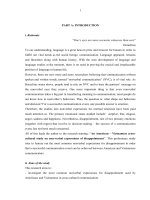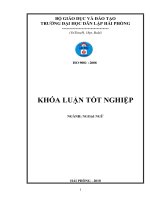A cross-cultural study on American-Vietnamese verbal expressions in confirming and negating
Bạn đang xem bản rút gọn của tài liệu. Xem và tải ngay bản đầy đủ của tài liệu tại đây (100.42 KB, 5 trang )
A cross-cultural study on American-Vietnamese
verbal expressions in confirming and negating
Đỗ Thị Phương Thanh
University of Languages and International Studies
M.A Thesis: English linguistic, Code: 60 22 15
Supervisor: Nguyễn Thị Bích Ngọc, MA
Year of graduation: 2012
Abstract: This study aimed at investigating the common verbal
expressions of confirming and negating used by American and Vietnamese
people in written form. For that reason, paralinguistic and nonverbal factors
are not discussed in this thesis. Another purpose was to find out the
similarities and differences between their ways of expressing confirming
and negating. The research applied the quantitative method and based on
the collection of authentic data. Through comparing the collected data from
the survey questionnaires, the study highlight the evidence that among
various confirming and negating strategies, both American and Vietnamese
employ politeness strategies with different preference. They try to use
formal language when communicating with partners of higher status or
people of different social position. The results of the study showed that the
choice of expressing confirming and negating depended much on the
communicating partners and communicating situations. The findings of this
thesis are hopefully a useful reference for other American-Vietnamese
cross-cultural communication researches.
Keywords: Giao văn hóa; Kỹ năng giao tiếp; Tiếng Anh; Việt Nam; Mỹ
Content
This minor thesis “A cross-culture study on American- Vietnamese verbal
expressions in confirming and negating” initiated from the facts that people from these
cultures often get into troubles when communicating with their partners. To have a better
understanding of the problem, the study has been conducted and the results are as
follows:
The Americans and Vietnamese express confirming and negating through the eight
communicative strategies: Bald On-Record, Joking, Hedging, Advising, Asserting
condition, Passing the ball to other(s), Asking Rhetoric Questions, and Don't do FTA.
Among these eight communicative strategies, "Bald On-Record" is the most frequently
used strategy.
The Americans and Vietnamese have both the similarity and differences in using the
communicative strategies. The Americans are similar to Vietnamese in attempts to show
their confirmation and negation directly by using "Bald On-Record" strategy. However,
the Americans and Vietnamese have their own preferred polite strategies. American
people show their directness by "Bald On-Record" strategy whereas Vietnamese people
reveal their indirectness by "Hedging" strategy in expressing confirming and negating.
Moreover, with the second most choice of "Joking" strategy, the Americans tend to be
more humorous than the Vietnamese in dealing with confirming and negating situations.
The data shows that the Americans seem to have freely choice of communicative
strategies while the Vietnamese are under the influence of such factors as: social distance,
status, group of interest, and communicating situations to express their confirmation and
negation. The Americans prefer On-Record strategies (ie. Bald On-Record and Joking),
while the Vietnamese are more in favor of Off-Record strategies (ie. Asserting condition
and Asking Rhetoric Questions).
To sum up, the similarity and differences in the findings are used to help the Americans
and Vietnamese can both give a deep impression and avoid making mistakes when
communicating with each other. In the field of cross-cultural communication, it is
necessary for everyone to improve their knowledge of the host culture. Moreover, people
who want to use appropriate communicative strategies should understand their partners'
behavior and culture. This is the key for the successful communication with people of
each society.
Luận văn “Nghiên cứu giao văn hóa Việt – Mỹ về cách diễn đạt khẳng định và phủ
định” được tiến hành từ thực tế nhiều người từ hai nền văn hóa này khi giao tiếp thường
gặp khó khăn để truyền tải ý nghĩ của mình. Để cải thiện vấn đề đó, đề tài đã tập trung
nghiên cứu thông qua câu hỏi khảo sát, và đã có một số kết quà.
Người Việt và người Mỹ thể hiện khẳng định và lphu3 định thông qua tám chiến lược
giao tiếp, đó là: Bald On-Record, Joking, Hedging, Advising, Asserting condition,
Passing the ball to other(s), Asking Rhetoric Questions, và Don't do FTA. Trong số đó,
"Bald On-Record" là chiến lược giao tiếp có tần số sử dụng nhiều nhất.
Cà người Việt và người Mỹ đều có những cách sử dụng các chiến lược giao tiếp giống
nhau và khác nhau để diễn đạt khẳng định và phủ định. Hai nền văn hóa đó có cách sử
dụng “Bald On Record” tương đương. Tuy nhiên có một số khác biết khi thể hiện khẳng
định và phủ định. Trong khi người Mỹ thích bày tỏ một cách trực tiếp thì người Việt lại
vòng vo, thậm chí là gián tiếp để thể hiện quan điểm của mình trong giao tiếp.
Những nhân tố ảnh hưởng tới sự khác nhau đó được cho là người Việt thường bị ảnh
hưởng bởi khoảng cách trong xã hội, địa vị công tác, nhu cầu, sở thích và tình huống giao
tiếp. Người Mỹ trong nghiên cứu này thể hiện khiếu hài hước nhiều hơn.
Kết quả nghiên cứu đã cho thấy sự giống nhau và khác nhau trong cách diễn đạt khẳng
định và phủ định giữa người Việt Nam và Mỹ, qua đó giúp mọi người ở hai nền văn hoá
gặp ít khó khăn hơn khi giao tiếp. Dưới góc độ giao tiếp giao văn hoá, kết quả này thật sự
cần thiết cho những ai muốn tăng vốn hiểu biết về văn hoá nước chủ nhà. Hơn nữa, thông
qua kết quả nghiên cứu, tác giả đã chỉ ra một số chiến lược giao tiếp phù hợp để giúp cho
việc giao tiếp thành công hơn.
References
IN ENGLISH
1. Austin, J. L. (1962), How to do things with words, Oxford: Oxford University
Press
2. Bach, K. and Harnish, R. (1973), Linguistic Communication and Speech Acts,
Massachusettes: The MIT Press
3. Back, K. (2011), Routledge Encyclopedia of Philosophy, entry Retrieved August 5
4. Bauman, Z. (1999), Culture as Praxis, Sage Publications
5. Brown, P. (1994), Politeness strategies and the attribution of intentions: The case
of Tzeltal irony, Cambridge: Cambridge University Press
6. Brown, P. and Levison, S. (1987), Politeness: Some Universals in Language
Usage, Cambridge: Cambridge University Press
7. Clow, F. R. (1920), Principles of Sociology with Educational Applications, The
Macmillan Company.
8. Cottril, M. (1994), Face, Politeness and Indirectness, University of Canberra
9. Creswell, W. J. (2003), Research design: qualitative, quantitative, and mixed
methods approaches, London: Sage Publications
10. Dang Thi Le Thu (2006), A cross-cultural study on expressing dislike in English
and Vietnamese - M. A Thesis, VNU - ULIS
11. DeVito, J.A. (1991), Human Communication: The Basic Course, 5th ed, Harper
Collins, New York.
12. DeVito, J.A. (1989), The Interpersonal Communication Book, 5th ed, Harper &
Row, New York.
13. Fraser, B. (1990), Perspective of politeness, Journal of Pragmatics, 14, 219-236
14. Geis, M. (1995), Speech Acts and Conversational Interaction, Cambridge:
Cambridge University Press
15. Green, G. M (1989), Pragmatics and Natural Language Understanding, USA:
Lawrence Erlbaum Associates, Inc.
16. Halliday, M.A.K. (1974), Language and Social Man, London: Longman
(Schools Council Programme in Linguistics & English Teaching, Papers, Series II, no. 3).
17. Hybels, S. & Weaver II, R.L (1992), Communicating effectively, Von Hoffman
Press Inc
18. Hymes, D. (1964), Language in Culture and Society, New York: Harper and Row
19. Kieu Thi Thu Huong (2001), Disagreeing in English and Vietnamese, MA Thesis.
VNU-CFL
20. Levinson, S. C. (1983), Pragmatics, Cambridge: Cambridge University Press
21. Leech, G. (1983), Principles of Pragmatics, London: Longman Group Limited
22. Lustig M. W., et. al.,(1996), Intercultural Competence, Harper Collins College
Publishers.
23. Lyon, J. (1981), Language and Linguistics - An Introduction, Cambridge:
Cambridge University Press
24. McKay, M., Davis, M. & Fanning P. (1983), Messages: The Communication
Skills Book, New Harbinger, Oakland, California.
25. Murphy, R. with Altman, R. (1989), English Grammar in Use, Cambridge:
Cambridge University Press
26. Nguyen Quang (1998), Intercultural Communication, VNU - ULIS
27. Nguyen Quang (1998), The negative sentence in English and Vietnamese - A
Contrastive Analysis, MA Thesis. VNU-CFL
28. Parson, T. (1949), Essays in Sociological Theory, Glencoe, IL.
29. Phan Thi Van Quyen (2001), Some English - Vietnamese Cross-cultural
Differences in refusing a request - M. A Thesis, VNU - ULIS
30. Quirk, R. and Greenbaum, S. (1973), A University of English Grammar, England:
Longman
31. Richard, I. et. al (1992), Longman Dictionary of Applied Linguistics, England:
Longman
32. Ronald. B. Adler & George Rodman (1998), Understanding Human
Communication, Oxford: Oxford University Press
33. Taylor, E. B. (1871), Primitive Culture, New York: J.P. Putnam’s Sons
34. Searle, J. R. (1981), Speech Acts, Second Edition. Cambridge: Cambridge
University Press
35. Searle, J. R. and Vanderveken, D. (1985), Foundations of Illocutionary Logic.,
Cambridge: Cambridge University Press.
36. Triandis, H (1994), Culture and Social Behavior, New York: McGraw-Hill
37. Wardhaugh, R. (1992), An Introduction to Sociolinguistics, 2nd ed, Oxford:
Blackwell Publisher
38. Yule, G. (1996), Pragmatics, Oxford: Oxford University Press
IN VIETNAMESE
1. Nguyễn Quang (2002). Giao tiếp và giao tiếp giao văn hoá, Nhà xuất bản Đại học
Quốc gia Hà Nội
2. Nguyễn Quang (2004). Một số vấn giao tiếp nội văn hoá văn giao văn hoá Nhà
xuất bản Đại học quốc gia Hà Nội.
3. Nguyễn Quang (2006) Giao tiếp phi ngôn từ qua các nền văn hoá. Nhà xuất bản
Khoa học Xã hội.
4. Nguyễn Quang (2007). Cách thức diễn đạt trong tiếng Anh - Ways of expressions
in English. NXB Từ điển Bách Khoa.
5. Nguyễn Văn Độ (2004). Tìm hiểu mối liên hệ Ngôn ngữ-Văn hoá., Nhà xuất bản
Đại học Quốc gia Hà Nội
THE INTERNET
1.
2.
3.









